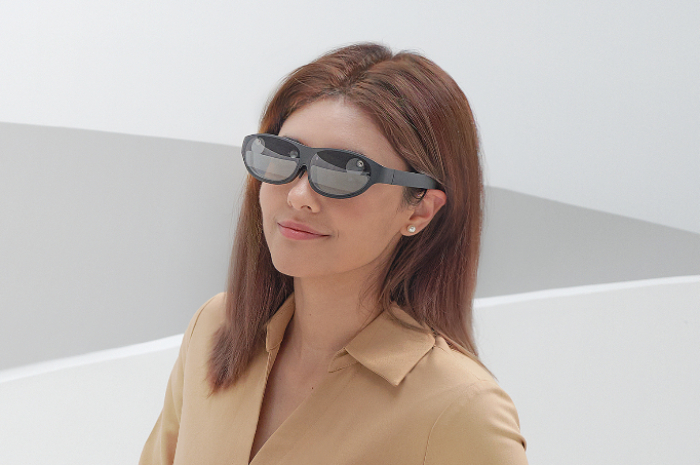Xreal (formerly Nreal), a China-based XR company, presented the launch of the Xreal Air 2 Ultra at CES 2024, marking the company’s comeback to augmented reality at the same time that Apple preparing for the launch of its $3,500 Vision Pro.
The Air 2 Ultra is the first gadget in the company’s most current line of glasses to feature inside-out tracking since the release of its consumer Nreal Light glasses in 2021.

Unlike the more recent Air 2 and Air 2 Pro, the Air 2 Ultra are ‘genuine’ AR glasses because they have cameras mounted on the device’s face.
Confusingly, the company refers to those previous devices as ‘AR’ as well, but they’re actually closer to smartglasses because they lack positional tracking and don’t support the type of room-sensing AR content suitable for HoloLens 2, Magic Leap 2, and MR headsets such as Quest 3 or Apple Vision Pro.
The new Air 2 Ultra, thanks to its dual cameras, can perform 6DOF positional tracking, image tracking, hand tracking, plane detection, depth meshing, and spatial anchoring of digital objects, putting it back in competition not only with the few companies developing consumer AR glasses but also with Meta and Apple, both of which have VR headsets capable of running AR apps (Meta Quest 3, Apple Vision Pro).
However, Xreal Air 2 Ultra is not a complete stand-alone package. The glasses, which are currently on pre-order for $700 and will ship in March, are designed to connect to Samsung S22 and S23 for AR purposes, as well as to iPhone 15, or any Mac or Windows PC that can run Xreal’s Nebula launcher.
Currently, the firm has no intentions to expand the list of supported phones for the Air 2 Ultra. The company claims, however, that it will eventually manufacture a specialized computer unit “for the best AR experience.”
Here’s the specifications:
| Size | Length: 148.5 mm Width: 48 mm Height: 161.5 mm |
| Weight | 80g |
| Display | 52 Degree FOV Micro OLED panel from SONY Resolution: 1920*1080 pixels per eye Refresh rate: Up to 120Hz (2D mode 120 Hz, 3D mode 90Hz) Brightness: Up to 500 nits (2D mode 30-500 nit, 3D mode 20-250 nit) Unit-based color calibration 3D refers to the 3840*1080 stereoscopic mode, while 2D refers to the 1920*1080 monoscopic mode. |
| LED Indicator Light | Two LED Indicator Lights |
| Ergonomic Design | Titanium Frame Zero-pressure Nose Pad (S/M/L) 3-position temple adjustment Detachable prescription lens frame (Air 2 ultra is not compatible with Air and Air 2 prescription lens frames) |
| Electrochromic Dimming | 3-level Electrochromic Dimming |
| Sensors | Two 3D environment sensors Video recording and photography are not supported |
| Human understanding | Hand tracking Head tracking |
| Environment understanding | 6 DoF Tracking Depth mesh Spatial Anchor Plane detection Image Tracking |
| Audio | 2 Built-in Stereo Speakers Sound leakage reduction 2 Microphones |
| Compatibility | Spatial Computing Samsung S22: OneUI 5.1, Snapdragon processor Samsung S23: OneUI 5.1/6.0, Snapdragon processor Screen Mirroring USB-C Video Output, HDMI Output devices iPhone, Android, MacBook, Steam Deck, ROG Ally, Windows PC XREAL Beam (3DoF) Nebula for Mac Beta |
| Buttons | Multi-functional key Single click to switch between dimming levels Double-click to turn on/off the display Up/Down button |
| TUV Certification | Flicker-free Low blue light Eye comfort Color Accuracy |
| Connector | USB-C DisplayPort Alt mode |
| In the Box | Air 2 Ultra USB-C cable Cleaning cloth Protective case User manual Nose pad (S/M/L) |
Conclusion
The Air 2 Ultra, Xreal makes a bold statement and throws down the gauntlet before Apple’s highly anticipated Vision Pro. The lightweight design, impressive specs, and competitive price tag position the Air 2 Ultra as a formidable challenger in the AR market. Whether it can steal the spotlight from Apple’s offering remains to be seen, but Xreal has undoubtedly made a compelling case for its innovative AR technology.











